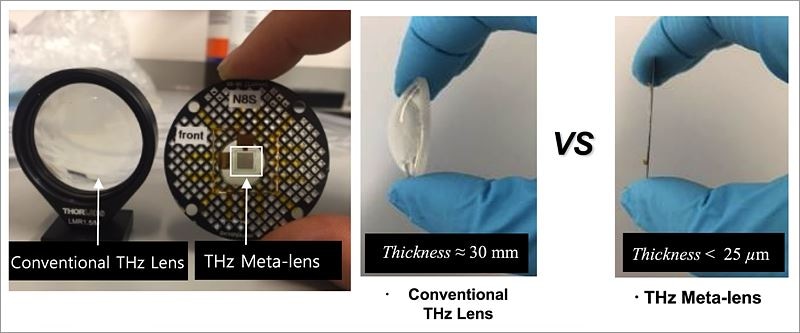Nov 28 2017
In the pursuit of miniaturization, researchers from the Center for Integrated Nanostructure Physics of the Institute for Basic Science (IBS), in South Korea, have partnered with researchers at the University of Birmingham and at the Korea Advanced Institute of Science and Technology (KAIST) to create flat lenses with the thickness of a credit card and with adjustable features.
The novel optical devices, made up of graphene and a punctured gold surface, might be utilized as optical components for cutting-edge applications, for example, lasers (i.e. vortex phase plates), amplitude tunable lenses, and dynamic holography.
 Comparison between conventional lenses and metalenses for terahertz (THz) radiation. Metalenses are ultrathin (around 25 micrometers in thickness) and also very flat compared with conventional ones. Credit: Institute for Basic Science
Comparison between conventional lenses and metalenses for terahertz (THz) radiation. Metalenses are ultrathin (around 25 micrometers in thickness) and also very flat compared with conventional ones. Credit: Institute for Basic Science
Metasurfaces are innovative 2D materials with the potential to efficiently regulate the magnetic and electric components of light (and similar electromagnetic waves) and deflect them in desired directions. Regulating the direction of the beam can unearth fascinating phenomena, the most magnificent of which is the “invisibility cloak effect.” In this effect, light waves elude an object, thereby recreating the image at a distance from the object, similar to flowing river water that eludes a stone.
The study, reported in the Advanced Optical Materials journal, exhibits the characteristics of a metasurface which functions like a convex lens. In particular, it is formed by using a gold sheet on which U-shaped, micrometer-sized holes are formed and covered by graphene. Considering the fact that the shape of common convex lenses enables light to be focused on a spot, or target, imagine a magnifying glass with the ability to focus a light beam and even initiate a fire such that the specific pattern of tiny apertures of the metalenses functions by concentrating the incoming beam.
Furthermore, the microholes also have the ability to alter light polarization. In contrast to natural light which is normally unpolarized prior to reflection, the researchers adopted circularly polarized waves, or a light beam in which the electric field direction is similar to corkscrew spiraling. This metalens has the potential to transform the left-circular polarization wave, which seems to be anticlockwise when viewed from front, into right-circular polarization, or clockwise polarization. The team managed to achieve a transformation rate of 35%. Transforming circular polarization can be helpful in various applications such as telecommunications and biosensing.
To regulate more characteristics, the team exploited the distinctive electronic properties of graphene and adopted them to adjust the amplitude or intensity of the output beam. In this case, graphene acts like the exposure of a camera. In a camera, a mechanical control enables the size and opening time of a specific shutter to govern the amount of light penetrating the instrument. In contrast, these metalenses control the exposure by applying an electric tension to the graphene sheet, thereby avoiding the necessity for using bulky components. Upon applying voltage to the graphene layer, the output beam is rendered weaker. “Using metalenses, you can make microscopes, cameras, and tools used in very sensitive optical measurements, much more compact,” clarified Teun-Teun Kim, the study’s first author.
The metalenses were patterned for a kind of electromagnetic wave known as terahertz radiation that is in-between microwave radiation and infrared radiation. This radiation has the ability to penetrate through certain materials, such as plastics and fabrics, yet at a lesser depth when compared microwave radiation, which makes it suitable for use in applications such as security screening and surveillance.
While conventional optical lenses have a thickness of several centimeters to several millimeters, this metalens is just a few tens of micrometers thick. The intensity of the focused light can be effectively controlled and it could find useful applications in ultra-small optical instruments.
Teun-Teun Kim Center for Integrated Nanostructure Physics of the Institute for Basic Science (IBS), in South Korea